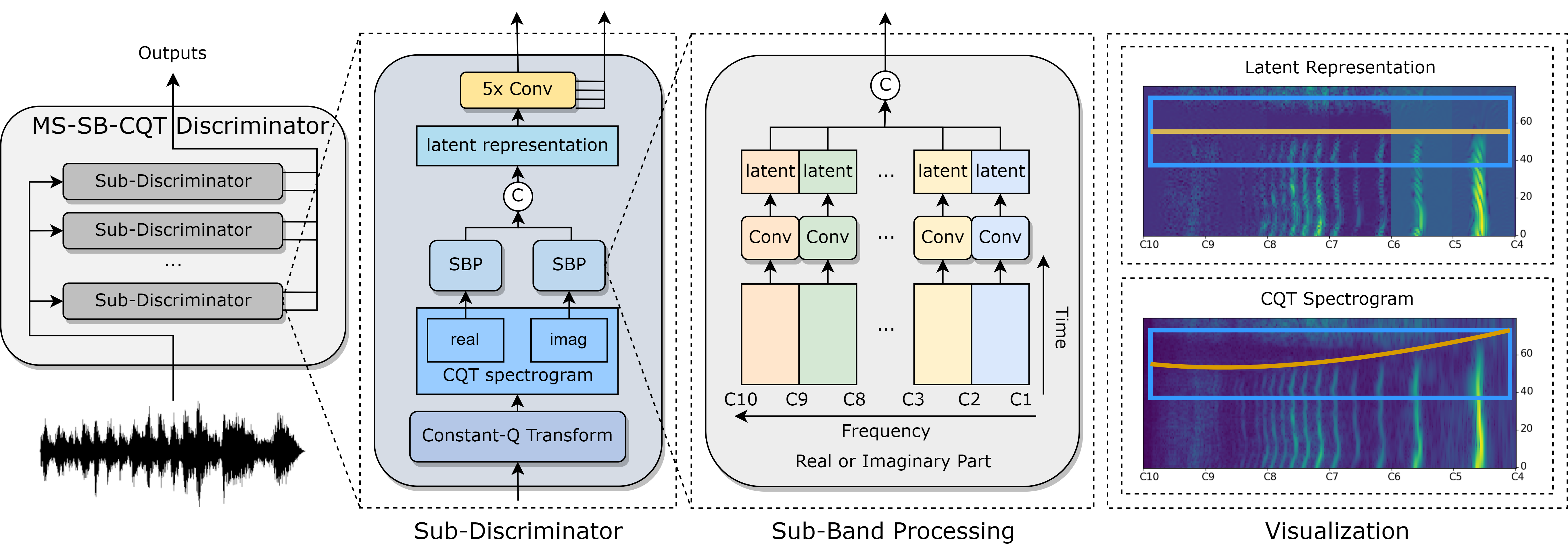Spaces:
Running
on
Zero
Multi-Scale Sub-Band Constant-Q Transform Discriminator for High-Fedility Vocoder

This is the official implementation of the paper "Multi-Scale Sub-Band Constant-Q Transform Discriminator for High-Fidelity Vocoder". In this recipe, we will illustrate how to train a high quality HiFi-GAN on LibriTTS, VCTK and LJSpeech via utilizing multiple Time-Frequency-Representation-based Discriminators.
There are four stages in total:
- Data preparation
- Feature extraction
- Training
- Inference
NOTE: You need to run every command of this recipe in the
Amphionroot path:cd Amphion
1. Data Preparation
Dataset Download
By default, we utilize the three datasets for training: LibriTTS, VCTK and LJSpeech. How to download them is detailed in here.
Configuration
Specify the dataset path in exp_config.json. Note that you can change the dataset list to use your preferred datasets.
"dataset": [
"ljspeech",
"vctk",
"libritts",
],
"dataset_path": {
// TODO: Fill in your dataset path
"ljspeech": "[LJSpeech dataset path]",
"vctk": "[VCTK dataset path]",
"libritts": "[LibriTTS dataset path]",
},
2. Features Extraction
For HiFiGAN, only the Mel-Spectrogram and the Output Audio are needed for training.
Configuration
Specify the dataset path and the output path for saving the processed data and the training model in exp_config.json:
// TODO: Fill in the output log path. The default value is "Amphion/ckpts/vocoder"
"log_dir": "ckpts/vocoder",
"preprocess": {
// TODO: Fill in the output data path. The default value is "Amphion/data"
"processed_dir": "data",
...
},
Run
Run the run.sh as the preproces stage (set --stage 1).
sh egs/vocoder/gan/tfr_enhanced_hifigan/run.sh --stage 1
NOTE: The
CUDA_VISIBLE_DEVICESis set as"0"in default. You can change it when runningrun.shby specifying such as--gpu "1".
3. Training
Configuration
We provide the default hyparameters in the exp_config.json. They can work on single NVIDIA-24g GPU. You can adjust them based on you GPU machines.
"train": {
"batch_size": 32,
...
}
Run
Run the run.sh as the training stage (set --stage 2). Specify a experimental name to run the following command. The tensorboard logs and checkpoints will be saved in Amphion/ckpts/vocoder/[YourExptName].
sh egs/vocoder/gan/tfr_enhanced_hifigan/run.sh --stage 2 --name [YourExptName]
NOTE: The
CUDA_VISIBLE_DEVICESis set as"0"in default. You can change it when runningrun.shby specifying such as--gpu "0,1,2,3".
If you want to resume or finetune from a pretrained model, run:
sh egs/vocoder/gan/tfr_enhanced_hifigan/run.sh --stage 2 \
--name [YourExptName] \
--resume_type ["resume" for resuming training and "finetune" for loading parameters only] \
--checkpoint Amphion/ckpts/vocoder/[YourExptName]/checkpoint \
NOTE: For multi-gpu training, the
main_process_portis set as29500in default. You can change it when runningrun.shby specifying such as--main_process_port 29501.
4. Inference
Pretrained Vocoder Download
We trained a HiFiGAN checkpoint with around 685 hours Speech data. The final pretrained checkpoint is released here.
Run
Run the run.sh as the training stage (set --stage 3), we provide three different inference modes, including infer_from_dataset, infer_from_feature, and infer_from audio.
sh egs/vocoder/gan/tfr_enhanced_hifigan/run.sh --stage 3 \
--infer_mode [Your chosen inference mode] \
--infer_datasets [Datasets you want to inference, needed when infer_from_dataset] \
--infer_feature_dir [Your path to your predicted acoustic features, needed when infer_from_feature] \
--infer_audio_dir [Your path to your audio files, needed when infer_form_audio] \
--infer_expt_dir Amphion/ckpts/vocoder/[YourExptName] \
--infer_output_dir Amphion/ckpts/vocoder/[YourExptName]/result \
a. Inference from Dataset
Run the run.sh with specified datasets, here is an example.
sh egs/vocoder/gan/tfr_enhanced_hifigan/run.sh --stage 3 \
--infer_mode infer_from_dataset \
--infer_datasets "libritts vctk ljspeech" \
--infer_expt_dir Amphion/ckpts/vocoder/[YourExptName] \
--infer_output_dir Amphion/ckpts/vocoder/[YourExptName]/result \
b. Inference from Features
If you want to inference from your generated acoustic features, you should first prepare your acoustic features into the following structure:
┣ {infer_feature_dir}
┃ ┣ mels
┃ ┃ ┣ sample1.npy
┃ ┃ ┣ sample2.npy
Then run the run.sh with specificed folder direction, here is an example.
sh egs/vocoder/gan/tfr_enhanced_hifigan/run.sh --stage 3 \
--infer_mode infer_from_feature \
--infer_feature_dir [Your path to your predicted acoustic features] \
--infer_expt_dir Amphion/ckpts/vocoder/[YourExptName] \
--infer_output_dir Amphion/ckpts/vocoder/[YourExptName]/result \
c. Inference from Audios
If you want to inference from audios for quick analysis synthesis, you should first prepare your audios into the following structure:
┣ audios
┃ ┣ sample1.wav
┃ ┣ sample2.wav
Then run the run.sh with specificed folder direction, here is an example.
sh egs/vocoder/gan/tfr_enhanced_hifigan/run.sh --stage 3 \
--infer_mode infer_from_audio \
--infer_audio_dir [Your path to your audio files] \
--infer_expt_dir Amphion/ckpts/vocoder/[YourExptName] \
--infer_output_dir Amphion/ckpts/vocoder/[YourExptName]/result \
Citations
@misc{gu2023cqt,
title={Multi-Scale Sub-Band Constant-Q Transform Discriminator for High-Fidelity Vocoder},
author={Yicheng Gu and Xueyao Zhang and Liumeng Xue and Zhizheng Wu},
year={2023},
eprint={2311.14957},
archivePrefix={arXiv},
primaryClass={cs.SD}
}


